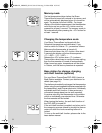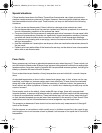
4
The Braun ThermoScan thermometer has been carefully developed for ac-
curate, safe and fast human body temperature measurements in the ear. The
shape of the thermometer probe prevents it from being inserted too far into the
ear canal which could perforate the tympanic membrane.
However, as with any thermometer, proper technique is critical to ob-
taining accurate temperatures. Therefore, please read all instructions
carefully and thoroughly before using this product.
Important
• Do not expose the thermometer to temperature extremes (below –4 ºF /
– 20 ºC or over 122 ºF / 50 ºC) nor excessive humidity (> 95 % RH).
• The probe window must be kept clean, dry, and undamaged at all times to
ensure accurate measurements. To protect the probe window, always keep
the thermometer in the storage cover while transporting or when not in use.
• This thermometer must only be used with genuine Braun ThermoScan
probe covers (PC 800).
• To avoid inaccurate measurements, always attach a new, clean probe cover
for each temperature measurement.
• If the thermometer is accidentally used without a probe cover attached,
clean the lens (see section «Care and cleaning»).
How does Braun ThermoScan work?
Braun ThermoScan measures the infrared heat generated by the eardrum and
surrounding tissues. To help ensure accurate temperature measurements, the
sensor itself is warmed to a temperature close to that of the human body. When
the Braun ThermoScan is placed in the ear, it continuously monitors the in-
frared energy until a temperature equilibrium has been reached and an ac-
curate measurement can be taken.
Why measure in the ear?
Clinical studies have shown that the ear is an excellent site for temperature
measurement because temperatures taken in the ear reflect the body’s core
temperature
1
. Body temperature is regulated by the hypothalamus
2
, which
shares the same blood supply as the tympanic membrane
3
. Changes in core
body temperature are usually seen sooner at the tympanic membrane than at
other sites, such as the rectum, mouth or under the arm.
Advantages of taking temperatures at the ear versus traditional sites:
• Axillary temperature measurements reflect skin temperature which may not
reliably indicate the internal body temperature.
• Rectal temperatures often lag significantly behind internal body temperature
changes, especially at times of rapidly changing temperatures. Also, there is
a risk of cross contamination.
• Oral temperatures are often influenced by eating, drinking, thermometer
placement, breathing through the mouth, or the inability of the person to
close their mouth completely.
1. Guyton A C, Textbook of medical physiology, W.B. Saunders, Philadelphia, 1996, p 919
2. Guyton A C, Textbook of medical physiology, W.B. Saunders, Philadelphia, 1996, pp 754-5
3. Netter H F, Atlas of Human Anatomy, Novartis Medical Education, East Hanover, NJ, 1997,
pp 63, 95
English
6021221_PRO4000_S4-46 Seite 4 Dienstag, 21. März 2006 10:24 10


















